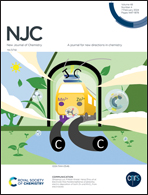Gd doped LaFeCuO3 perovskites for enhanced olefin selectivity in CO2 hydrogenation
Abstract
LaGdFeCuO3 composite catalysts were prepared by a hydrothermal method using glucose as the carbon source and were used to investigate the properties of CO2 activation and hydrogenation to light olefins. Various characterization techniques have been employed to reveal the relationship between the catalytic activity and the catalyst structure. The results demonstrated that the morphology of the sample is a cage branch chain structure. Gd decreases the interface effect and structural stability, enhances active metal exudation, and facilitates lattice oxygen migration. In CO2 hydrogenation, the predominant products were C2–C4 hydrocarbons in the Gd doped LaFeCuO3 samples. The catalytic activity of Cu doping first increased and subsequently reduced with an increase in the Cu/Fe molar ratio. When the Cu/Fe molar ratio is 0.75, the olefin selectivity is the highest. The results demonstrate the relationship between olefin selectivity and perovskite oxygen mobility, as determined from oxygen vacancies and oxygen diffusivity, and the anchoring effect of reduced metal nanoparticles that create C–O bonds on the catalytic surface. These investigations offer a theoretical framework for the creation of dual-function Fe-based perovskite catalysts for CO2 hydrogenation.



 Please wait while we load your content...
Please wait while we load your content...